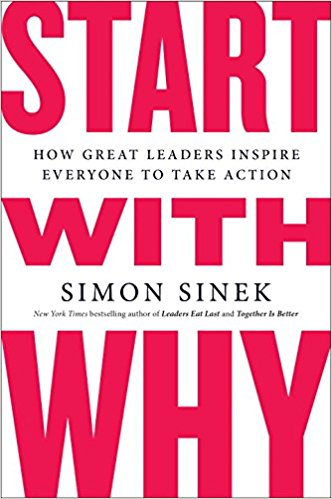Start with Why: How Great Leaders Inspire Everyone to Take Action, by Simon Sinek. (2009). NY: Portfolio/Penguin.
“People don’t buy what you do; they buy why you do it.” Simon Sinek repeats these two phrases a dozen times or more during the famous TED Talk that inspired this book. It’s a simple concept that is incredibly empowering: why you do something is more important than either what you do or how you do it. “Why” is the inspiration that makes people follow you or buy your products. “Why” might include your belief system or why you get up in the morning, and for Sinek, you should be able to express it in words.
Sinek’s personal life purpose is to inspire people to do whatever it is they want to do, and he’s good at it. He believes that products that are infused with the “why” of a company’s existence will be more successful than those that are based on “what” or “how.” Throughout the book, he relies on the examples of Apple, Martin Luther King, Jr., and the Wright brothers as successful thought leaders that inspired people with their use of “why.” Apple’s “why” is to challenge the status quo. Dr. King’s “why” was to change America with the civil rights movement. Orville and Wilbur Wright wanted to learn to fly more than they wanted to make a name for themselves or create a fortune, although they succeeded in doing all of those things.
In one sense, the book is about marketing. For example, Sinek talks about how inspiration is more effective at influencing human behavior than manipulation. “From business to politics, manipulations run rampant in all forms of sales and marketing. Typical manipulations include: dropping the price, running a promotion, using fear, peer pressure or aspirational messages; and promising innovation to influence behavior—be it a purchase, a vote or support.” Manipulations work, but not a single one of them breeds loyalty. “Over the course of time, they cost more and more. The gains are only short-term.”
Manipulations are about “what” and “how.” They are not about “why.” Remember: “People don’t buy what you do; they buy why you do it.” Only if people understand why you are offering a product or skill will they decide whether they believe the same way you do. If they do, they will be loyal to you, regardless of price point or other manipulations.
In another sense, the book is a reminder that we need to reconsider what brings meaning to our lives. The leader of a company needs to be clear, in his/her mind, why the company exists and to be able to express it to employees. The next level down is the “how” level. These are typically the senior executives who are inspired by the leader’s vision and know how to bring it to life. The “what” level includes the people who implement the strategy and interact with customers.
Sinek says, “No matter how charismatic or inspiring the leader is, if there are not people in the organization inspired to bring that vision to reality, to build an infrastructure with systems and processes, then at best, inefficiency reigns, and at worst, failure results.” Everyone, whether they are the “why,” “how,” or “what” of an organization, needs to feel inspired to get out of bed and go to work every day. In other words, if this job isn’t doing it for you, then you need to figure out what you really want to do and do that instead. Find your own “why.”
According to Sinek, when the “why” gets fuzzy, organizations tend to go downhill. He uses the example of Walmart, which started focusing on the fiscal bottom line rather than fairness after Sam Walton died. When that happened, the company began to rack up lawsuits for its poor treatment of employees. Sinek says making money is never a “why” and will never sustain a business.
Another example is TiVo, which, despite having a superior product, has never been a financial success. The company’s marketing materials talk about what their product does and how it works instead of focusing on the fact that it allows people to have total control over their viewing habits (the “why”).
For the most part, I was excited to read this book. It presents innovative ideas that inspired me to think deeply about what I’m doing and why. After a while, though, I grew restive with the constant focus on Apple and a few other companies. And the message about the need to focus on “why,” albeit fascinating, ultimately became redundant. I raced through the first half of the book and trudged through the second half. You may have a different experience. Either way, it’s worth giving this book a read. Even if you don’t make it to the end, I’m convinced that you will be inspired to think differently about what you do.

